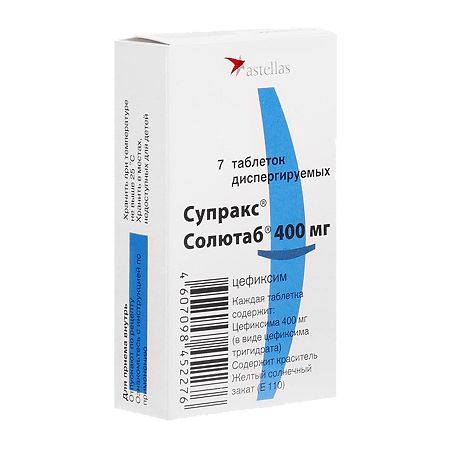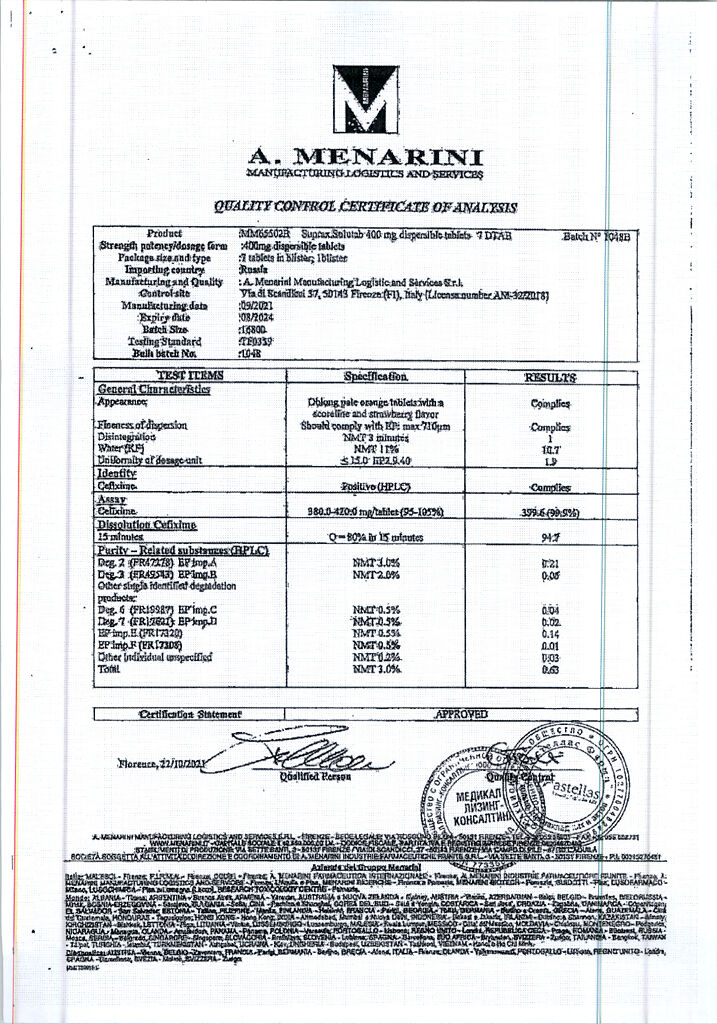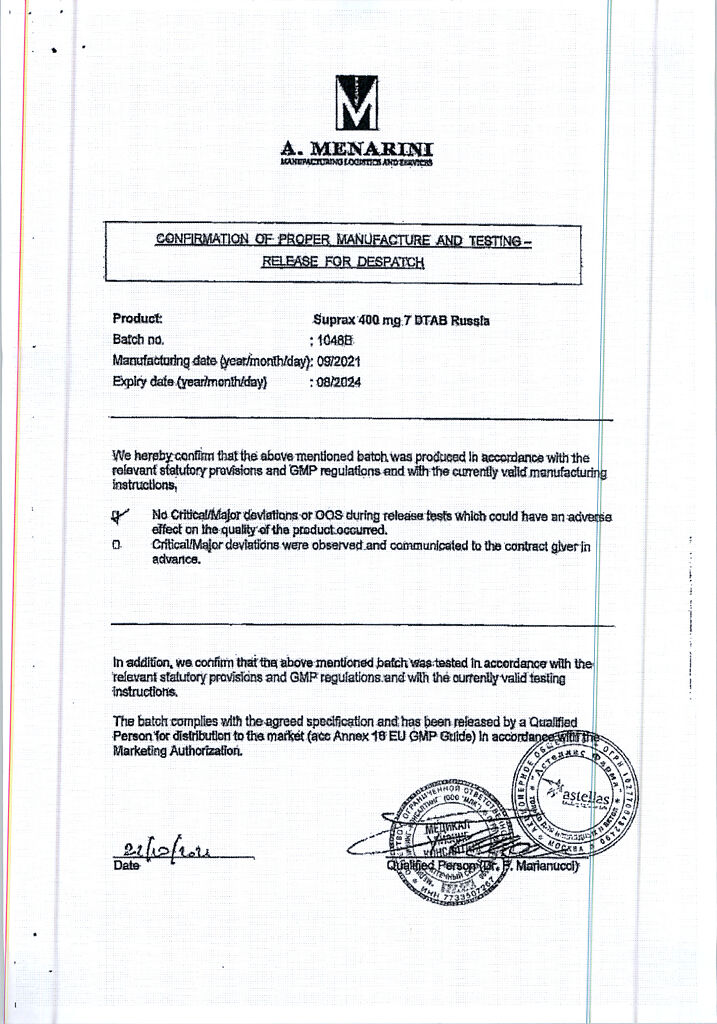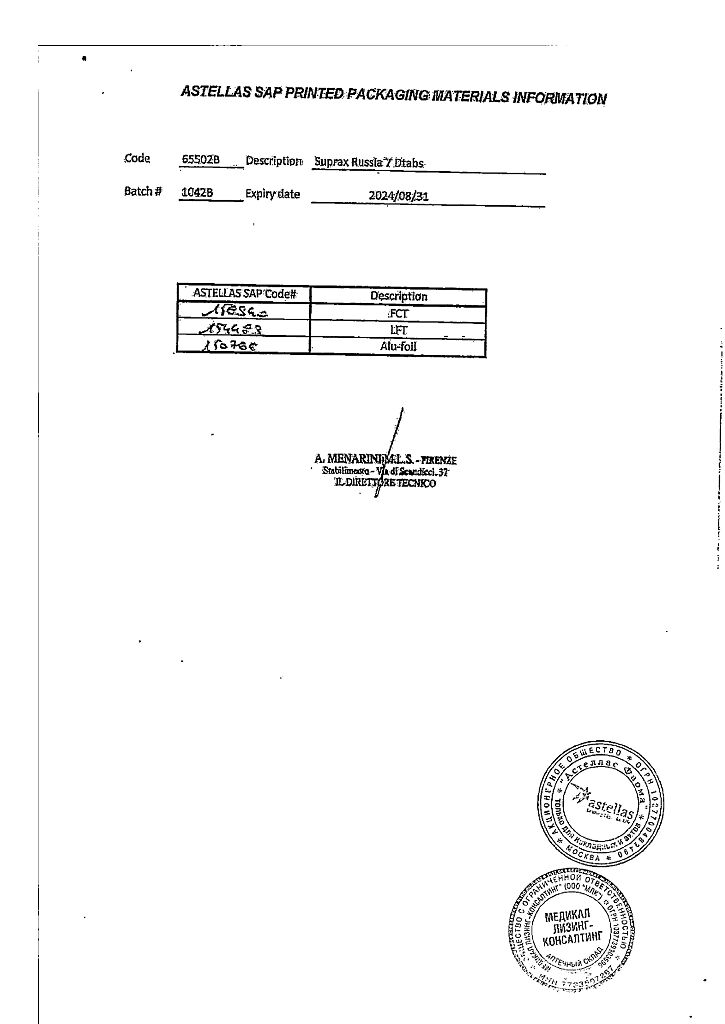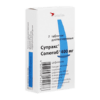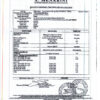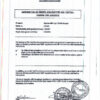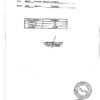No products in the cart.
Suprax Solutab, 400 mg 7 pcs
€38.55 €32.12
Out of stock
(E-mail when Stock is available)
Description
Pharmacotherapeutic group:
Cephalosporin antibiotic.
ATC code: [J01DD08]
Pharmacological properties
Pharmacodynamics:
Mechanism of action
A semi-synthetic oral cephalosporin III generation antibiotic. It has a bactericidal effect. The mechanism of action is related to inhibition of the synthesis of the bacterial cell wall. Cefixime is resistant to p-lactamases produced by many Gram-positive and Gram-negative bacteria.
The spectrum of antimicrobial activity
In clinical practice and in vitro the efficacy of cefixime has been confirmed in infections caused by Streptococcus pneumoniae, Streptococcus pyogenes, Haemophilus influenzae, Moraxella catarrhalis, Escherichia coli, Proteus mirabilis, Neisseria gonorrhoeae.
Cefixime also has activity in vitro against Gram-positive -Streptococcus agalactiae and Gram-negative bacteria – Haemophilus parainfluenzae, Proteus vulgaris, Klebsiella pneumoniae, Klebsiella oxytoca, Pasteurella multocida, Providencia spp, Salmonella spp., Shigella spp., Citrobacter amalonaticus, Citrobacter diversus.
Pseudomonas spp., Enterococcus spp., Listeria monocytogenes, most strains of Enterobacter spp., Staphylococcus spp. (including methicillin-resistant strains), Bacteroides fragilis, Clostridium spp.
Pharmacokinetics:
Absorption
In oral administration bioavailability is 40-50% and does not depend on food intake. Maximal blood plasma concentration (Cmax) in adults is reached after 3-4 hours after an oral dose of 400 mg and is 2.5-4.9 µg/ml, after a dose of 200 mg – 1.49-3.25 µg/ml. Food intake has no significant effect on absorption of the drug from the gastrointestinal tract.
Distribution
The volume of distribution after administration of 200 mg of cefixime was 6.7 l, when reaching equilibrium concentration – 16.8 l. About 65% of cefixime binds to plasma proteins. The highest concentrations of cefixime are in urine and bile. Cefixime penetrates through the placenta. The concentration of cefixime in umbilical cord blood reached 1/6-1/2 of the drug concentration in maternal plasma; the drug was undetectable in breast milk.
Metabolism and excretion
The elimination half-life in adults and children is 3-4 h. Cefixime is not metabolized in the liver; 50-55% of the administered dose was excreted unchanged in the urine within 24 hours. About 10% of cefixime is excreted with the bile.
Pharmacokinetics in special clinical situations
In patients with renal insufficiency a longer half-life and correspondingly higher concentration of the drug in plasma and delayed elimination by the kidneys can be expected. In patients with creatinine clearance of 30 ml/min receiving cefixime 400 mg, the half-life period is increased up to 7-8 h, maximum concentration in plasma is on average 7.53 µg/ml, and excretion with urine – 5.5% within 24 hours. In patients with liver cirrhosis, the elimination half-life increases to 6.4 hours, the time to reach maximum concentration (TCmax) – 5.2 hours; simultaneously, the proportion of the drug eliminated by the kidneys increases. Cmax and area under the pharmacokinetic curve do not change.
Indications
Indications
Infectious and inflammatory diseases caused by microorganisms sensitive to the drug:
– streptococcal tonsillitis and pharyngitis;
– sinusitis;
– acute bronchitis;
– exacerbation of chronic bronchitis;
– acute otitis media;
– uncomplicated urinary tract infections;
– uncomplicated gonorrhea;
– shigellosis.
Pharmacological effect
Pharmacological effect
Pharmacotherapeutic group:
Antibiotic cephalosporin.
ATX code: [J01DD08]
Pharmacological properties
Pharmacodynamics:
Mechanism of action
Semi-synthetic antibiotic from the group of third-generation cephalosporins for oral administration. Has a bactericidal effect. The mechanism of action is associated with inhibition of bacterial cell wall synthesis. Cefixime is resistant to the action of β-lactamases produced by many gram-positive and gram-negative bacteria.
Spectrum of antimicrobial activity
In clinical practice and in vitro, the effectiveness of cefixime has been confirmed for infections caused by Streptococcus pneumoniae, Streptococcus pyogenes, Haemophilus influenzae, Moraxella catarrhalis, Escherichia coli, Proteus mirabilis, Neisseria gonorrhoeae.
Cefixime also has in vitro activity against gram-positive – Streptococcus agalactiae and gram-negative bacteria – Haemophilus parainfluenzae, Proteus vulgaris, Klebsiella pneumoniae, Klebsiella oxytoca, Pasteurella multocida, Providencia spp., Salmonella spp., Shigella spp., Citrobacter amalonaticus, Citrobacter diversus.
Pseudomonas spp., Enterococcus spp., Listeria monocytogenes, most strains of Enterobacter spp., Staphylococcus spp. are resistant to the drug. (including methicillin-resistant strains), Bacteroides fragilis, Clostridium spp.
Pharmacokinetics:
Absorption
When taken orally, bioavailability is 40-50% and does not depend on food intake. The maximum concentration in blood plasma (Cmax) in adults after oral administration at a dose of 400 mg is reached after 3-4 hours and is 2.5-4.9 mcg/ml, after administration at a dose of 200 mg – 1.49-3.25 mcg/ml. Eating does not have a significant effect on the absorption of the drug from the gastrointestinal tract.
Distribution
The volume of distribution with the introduction of 200 mg of cefixime was 6.7 l, when the equilibrium concentration was reached – 16.8 l. About 65% of cefixime binds to plasma proteins. Cefixime creates the highest concentrations in urine and bile. Cefixime crosses the placenta. The concentration of cefixime in the blood of the umbilical cord reached 1/6-1/2 the concentration of the drug in the maternal blood plasma; The drug is not detected in breast milk.
Metabolism and excretion
The half-life in adults and children is 3-4 hours. Cefixime is not metabolized in the liver; 50-55% of the dose taken was excreted unchanged in the urine within 24 hours. About 10% of cefixime is excreted in the bile.
Pharmacokinetics in special clinical situations
If a patient has renal failure, an increase in the half-life and, accordingly, a higher plasma concentration of the drug and a slower elimination of it by the kidneys can be expected. In patients with a creatinine clearance of 30 ml/min, when taking 400 mg of cefixime, the half-life increases to 7-8 hours, the maximum plasma concentration averages 7.53 mcg/ml, and urinary excretion in 24 hours is 5.5%. In patients with liver cirrhosis, the half-life increases to 6.4 hours, the time to reach maximum concentration (TCmax) is 5.2 hours; at the same time, the proportion of the drug eliminated by the kidneys increases. Cmax and area under the pharmacokinetic curve do not change.
Special instructions
Special instructions
Due to the possibility of cross-allergic reactions with penicillins, it is recommended to carefully evaluate the patient’s medical history. If an allergic reaction occurs, use of the drug should be stopped immediately.
If toxic epidermal necrolysis (Lyell’s syndrome), Stevens-Johnson syndrome, drug rash syndrome with eosinophilia and systemic manifestations occur, cefixime should be discontinued and the necessary therapy should be carried out.
If anaphylactic shock develops, the drug must be stopped and epinephrine (adrenaline), systemic glucocorticosteroids and antihistamines administered.
Long-term use of the drug may disrupt the normal intestinal microflora, which can lead to excessive proliferation of Clostridium difficile and the development of pseudomembranous colitis. If mild forms of antibiotic-associated diarrhea occur, it is usually sufficient to stop taking the drug. For more severe forms, corrective treatment is recommended (for example, vancomycin 250 mg orally 4 times a day). Antidiarrheal drugs that inhibit gastrointestinal motility are contraindicated in the development of pseudomembranous colitis.
Like other cephalosporins, cefixime can cause acute renal failure accompanied by tubulointerstitial nephritis. In case of acute renal failure, you should stop taking cefixime, take the necessary measures and/or prescribe appropriate treatment.
If Suprax® Solutab® is used simultaneously with aminoglycosides, polymyxin B, sodium colistimethate, and loop diuretics (furosemide, ethacrynic acid) in high doses, it is necessary to monitor renal function. After long-term treatment with Suprax® Solutab®, the state of hematopoietic function should be checked.
Dispersible tablets should only be dissolved in water. During treatment, a false-positive direct Coombs test and a false-positive urine test for glucose are possible when using some test systems for rapid diagnosis.
Active ingredient
Active ingredient
Cefixime
Composition
Composition
1 tablet contains:
Active substance:
cefixime – 400 mg (as cefixime trihydrate 447.7 mg)
Excipients: microcrystalline cellulose 44.5 mg, low-substituted hyprolose 40.0 mg, colloidal silicon dioxide 5.0 mg, povidone 5.0 mg, magnesium stearate 10.0 mg, calcium saccharinate trisesquihydrate 20.0 mg, strawberry flavor FA 15757 5.0 mg, strawberry flavor PV 4284) 2.5 mg, sunset yellow dye (E110) 0.3 mg.
Pregnancy
Pregnancy
The use of Ceforal Solutab during pregnancy is possible when the expected benefit to the mother outweighs the potential risk to the fetus.
If it is necessary to use the drug during lactation, breastfeeding should be temporarily stopped.
Contraindications
Contraindications
– hypersensitivity to cefixime or components of the drug;
– hypersensitivity to cephalosporins or penicillins;
– not recommended for use in children with chronic renal failure and in children weighing less than 25 kg in this dosage form
With caution
Old age, renal failure, colitis (history), pregnancy.
Side Effects
Side Effects
Side effects are classified according to the frequency of reported cases:
Very common: (>10%); often (1-10%); infrequently (0.1-1%); rarely (0.01-0.1%); very rare (≤0.01%);
From the blood system and hematopoietic organs:
Very rare: transient leukopenia, agranulocytosis, pancytopenia, thrombocytopenia or eosinophilia. Isolated cases of blood clotting disorders have been reported.
Frequency unknown: hemolytic anemia
Allergic reactions:
Rare: allergic reactions (eg, urticaria, rash, erythema multiforme, pruritus).
Very rare: Lyell’s syndrome (toxic epidermal necrolysis); other allergic reactions associated with sensitization – drug fever, a syndrome similar to serum sickness, hemolytic anemia and interstitial nephritis, Stevens-Johnson syndrome, anaphylactic shock. In some patients, cases of drug rash syndrome with eosinophilia and systemic manifestations have been reported.
From the nervous system:
Uncommon: headaches, dizziness, dysphoria, anxiety.
From the respiratory system:
Frequency unknown: dyspnea.
Reactions from the digestive system:
Common: abdominal pain, indigestion, nausea, vomiting and diarrhea.
Very rare: pseudomembranous colitis.
From the hepatobiliary system:
Rarely: increased activity of alkaline phosphatase and “liver” transaminases, increased concentration of bilirubin in the blood.
Very rare: isolated cases of hepatitis and cholestatic jaundice.
From the genitourinary system:
Very rare: slight increase in the concentration of creatinine and urea in the blood, hematuria, possible development of acute renal failure accompanied by tubulointerstitial nephritis.
Interaction
Interaction
Tubular secretion blockers (probenecid, etc.) slow down the excretion of cefixime through the kidneys, which can lead to overdose symptoms.
Cefixime reduces the prothrombin index and enhances the effect of indirect anticoagulants.
With simultaneous use of cefixime with carbamazepine, an increase in the concentration of the latter in plasma was observed; in such cases, therapeutic drug monitoring is advisable.
Overdose
Overdose
When taken at a dose exceeding the maximum daily dose, an increase in the frequency of the dose-dependent side effects described above is possible.
Treatment: gastric lavage; carry out symptomatic and supportive therapy. Hemodialysis and peritoneal dialysis are not effective.
Storage conditions
Storage conditions
Store at a temperature not exceeding 25°C.
Keep out of the reach of children.
Shelf life
Shelf life
3 years. Do not use after the expiration date stated on the package.
Manufacturer
Manufacturer
A. Menarini Manufacturing Logistics and Services S, Italy
Additional information
| Shelf life | 3 years. Do not use after the expiration date stated on the package. |
|---|---|
| Conditions of storage | Store at a temperature not exceeding 25°C. Keep out of the reach of children. |
| Manufacturer | A.Menarini Manufechering Logistics and Services S, Italy |
| Medication form | dispersible tablets |
| Brand | A.Menarini Manufechering Logistics and Services S |
Related products
Buy Suprax Solutab, 400 mg 7 pcs with delivery to USA, UK, Europe and over 120 other countries.

